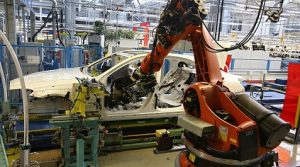 According to Eurostat, Romania ranked in 2018 among lagging countries that use robots in industrial processes or in services, with a proportion of 3% of companies, along with Estonia, Greece, Lithuania and Hungary.
According to Eurostat, Romania ranked in 2018 among lagging countries that use robots in industrial processes or in services, with a proportion of 3% of companies, along with Estonia, Greece, Lithuania and Hungary.
The smallest percentage, less relevant due to the small size of the economy, was recorded in Cyprus (1%).
Somewhat surprising but noteworthy for our country’s strategic decisions, Spain (11%), Denmark, Finland (10%, each) and Italy (9%) are top countries in terms of using robots.
The EU average was more than double compared to the situation in Romania, with 7% of companies having at least 10 employees that are using robots.
Large enterprises (at least 250 employees) recorded the highest proportion of robotization (25%), at a far distance from the mid-sized companies (50-249 persons), which were positioned at less than a half (12%) and small businesses (10 to 49 people) that obtained only 5%.
The explanation is given by the relatively significant cost of the initial investment, even though the subsequent benefits in productivity growth are obvious.
In terms of usage, the segment with the largest share of robots used was the sector of warehouse management systems (44% of companies), followed by passenger or goods transport (22%) and cleaning and waste treatment systems, as well as the assembling activity (21% each).
Methodological note
Robots consist of several components that involve a mechanical structure, sensors, a computer and a control unit. By usage purpose, they are structured in industrial and service robots. Industrial robots are mainly used in industrial automation and perform their tasks in a clearly structured environment with external safety measures. Service robots operate at a certain level of autonomy in a more complex environment and may involve interaction with people, objects, or other devices.
Companies use industrial robots (5%) more often than robots for services (2%). Industrial robots are most commonly used in the manufacturing sector (16%) while service robots appear most often in manufacturing and the retail sector (4% each).
Given the fact that Romania has an increasing workforce deficit and the productivity level registered in 2017 was less than 25% of the EU average (EUR 9.30 per working hour compared to EUR 33.13 per working hour in the EU and EUR 38.23 in the Eurozone), steps would be needed to speed up the robotization of the economy and prepare the appropriate measures.










